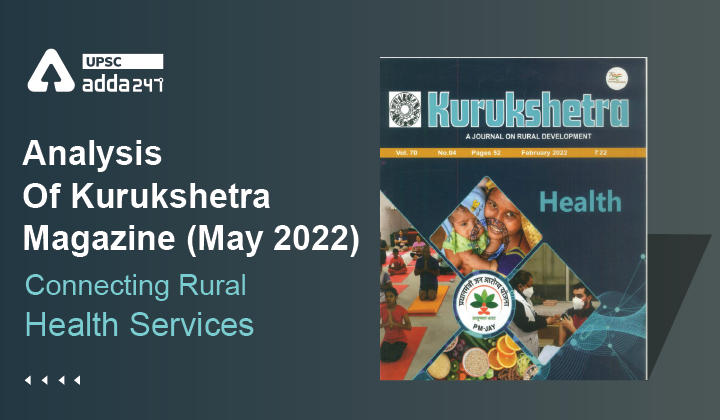Table of Contents
”Connecting Rural Health Services”
Introduction
Over the last several years, the GOI through the National Health Mission, National Health Policy and Ayushman Bharat Mission, among other initiatives has improved the health of its population, narrowing the rural-urban and rich-poor divide.
3 Tier System of Rural Healthcare
The Primary Health Care Infrastructure has been developed as a three tier system with Sub Centre, Primary Health Centre (PHC) and Community Health Centre (CHC) being the three pillars of Primary Health Care System.
Sub Centre
The Sub-Centre is the most peripheral and first contact point between the primary health care system and the community. Each Sub-Centre is required to be manned by at least one Auxiliary Nurse Midwife (ANM) / Female Health Worker and one Male Health Worker.
Primary Health Centre (PHC)
PHC is the first contact point between village community and the Medical Officer. The PHCs were envisaged to provide an integrated curative and preventive health care to the rural population with emphasis on preventive and promotive aspects of health care. The PHCs are established and maintained by the State Governments under the Minimum Needs Programme (MNP)/ Basic Minimum Services (BMS) Programme.
Community Health Centre (CHC)
CHCs are being established and maintained by the State Government under MNP/BMS programme. As per minimum norms, a CHC is required to be manned by four Medical Specialists i.e. Surgeon, Physician, Gynecologist and Pediatrician supported by 21 paramedical and other staff.
Population Norm for Public Health Facilities
To provide assured access to health care services, Government of India has defined population norm for public health facilities through Indian Public Health Standards (IPHS) in rural areas as stated below:
| Sr.
No. |
Public health facilities | Plain area | Hilly/tribal/difficult area |
| 1 | SC | 5000 | 3000 |
| 2 | PHC | 30000 | 20000 |
| 3 | Non FRU CHC | 1,20000 | 80000 |
| 4 | FRU CHC | 500000 | NA |
AB-PMJAY and Rural Healthcare
- Ayushman Bharat – Pradhan Mantri Jan AarogyaYojana (AB-PMJAY) was launched on 23rd September, 2018 at Ranchi, Jharkhand.
- PM Ayushman Bharat Health Infrastructure Mission (PM-ABHIM) envisages increased investments in public health and other health reforms to provide better access to health in rural areas by:
-
- Strengthening of Health and Wellness Centres in villages and cities for early detection of diseases.
- Addition of new critical care-related beds at district-level hospitals.
- Support for Block Public Health Units (BPHU) in 11 high focus states.
- Integrated district public health laboratories in all districts.
- Under Ayushman Bharat, the existing Sub-health Centres (SHCs) and Primary Health Centres (PHCs) are being transformed into AB-HWCs to deliver twelve packages of Comprehensive Primary Health Care (CPHC) that includes preventive, promotive, curative, palliative and rehabilitative services which is universal, free and close to the community.
National Health Mission (NHM) and Rural Healthcare
- The National Rural Health Mission (NRHM) was launched by the Hon’ble Prime Minister on 12th April 2005, to provide accessible, affordable and quality health care to the rural population, especially the vulnerable groups.
- Financial and technical support is provided to States/UTs to strengthen their health care systems including rural areas based on requirements posed by the States in their Programme Implementation Plans (PIPs).
- NHM support is also provided for provision of a range of free services related to maternal health, child health, adolescent health, family planning, universal immunisation programme, and for major diseases such as Tuberculosis, vector borne diseases like Malaria, Dengue and Kala Azar, Leprosy etc.
- Other major initiatives supported under NHM include Janani Shishu Suraksha Karyakram (JSSK), Rashtriya Bal Swasthya Karyakram (RBSK), implementation of Free Drugs and Free Diagnostics Service Initiatives, PM National Dialysis Programme and implementation of National Quality Assurance Framework in all public health facilities including in rural areas.
- Incentives and honorarium is provided to staff for ensuring service delivery in rural and remote areas of the country by NHM.
National Health Policy
- The National Health Policy of 1983 and the National Health Policy of 2002 have served well in guiding the approach for the health sector in the Five-Year Plans.
- The National Health Policy, 2017 (NHP, 2017) seeks to reach everyone in a comprehensive integrated way to move towards wellness. It aims at achieving universal health coverage and delivering quality health care services to all at affordable cost.
National Teleconsultation Service
- National Teleconsultation Service of Ministry of Health and Family Welfare is first of its kind online OPD service offered by a country government to its citizens.
- National Teleconsultation Service aims to provide healthcare services to patients in their homes. Safe & structured video based clinical consultations between a doctor in a hospital and a patient in the confines of his home are being enabled.
eSanjeevani
Ayushman Bharat-Health and Wellness Centre (AB-HWC)
- A Doctor-to-Doctor telemedicine service under Ayushman Bharat-Health and Wellness Centres scheme of Government of India, to provide general and specialised health services in rural areas and isolated communities.
- Doctor-to-Doctor telemedicine service is based on a Hub-and-Spoke model. ‘eSanjeevani AB-HWC’ enables virtual connection between the beneficiary (along with paramedic and a generalist) at the spoke i.e. HWC and doctor/specialist at the hub (tertiary healthcare facility/hospital/medical college).
- This facilitates real-time virtual consultation from doctors & specialists at the hub with the beneficiary through paramedics at the spoke.
eSanjeevaniOPD
- This is a patient-to-doctor telemedicine service to enable people to get outpatient services in the confines of their homes. ‘eSanjeevaniOPD’ has also been speedily and widely adopted by citizens in all parts of the country.
- It is available as a mobile app for both Android and iOS-based smartphones, and these apps have seen over 3 million downloads.



 TSPSC Group 1 Question Paper 2024, Downl...
TSPSC Group 1 Question Paper 2024, Downl...
 TSPSC Group 1 Answer key 2024 Out, Downl...
TSPSC Group 1 Answer key 2024 Out, Downl...
 UPSC Prelims 2024 Question Paper, Downlo...
UPSC Prelims 2024 Question Paper, Downlo...




